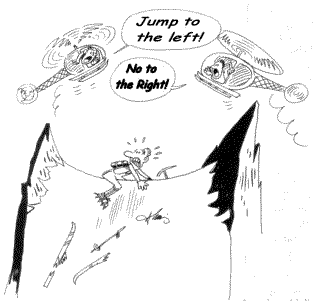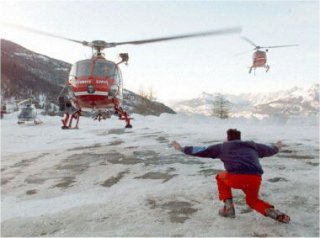
Articles > Off Piste Insurance > Search and Rescue Costs
In France the Mayor is responsible for the security of his community but there is an exception for mountains where the State, and its representative the Préfet (governor) are responsible. The Préfet must establish a security plan based around the gendarmerie, the PGHM (High Mountain Police), special units of the CRS, Civil Security and the Fire Brigade. Particular care must be taken with climbing areas and sectors that attract a large number of visitors (les Ecrins, Mont Blanc etc). Mountain rescue is expressly excluded from the competence of the Mayor and the costs are borne by the French state (see below).
However ski stations are considered as belonging to the local community and safety within the ski domain is specifically the responsibility of the local Mayor and his experts. The Mayor must ensure that natural obstacles such as rocks and cliffs are signposted and if necessary secured with nets, dangerous pistes are closed etc. He must also establish a rescue service for the domain and publish the costs of usage. This covers alpine and cross-country skiing and snowboarding in all its forms, snow shoeing is currently a grey area. There are also apocryphal stories about how you can ask to be rescued by the Gendarmerie or fire-brigade or if the rescue service don't carry your equipment you won't have to pay. It is safe to assume that any sort of accident within the ski area is will be charged at the rate established by the Mayor, typically 300 Euros for a recovery on stretcher and up to 2000 Euros for a helicopter. After that there might be a ride on a private ambulance to the hospital

This leads to the somewhat strange circumstance that, say you are in Courchevel and climbing the ridge to descend the Col du Fruit, if you fall into the Creux bowl you will have to pay to be rescued by the pisteurs from the resort and if you fall into the Valley du Fruit a helicopter will be scrambled and you will be recovered totally free of charge. When you consider a helicopter costs around 2500 Euros per hour and a search and rescue could take several days and involve hundreds of trained personnel in the worst case this is just as well.
In February, 1999 three climbers went missing for four days on the Dômes de la Vanoise during a period of high avalanche risk. After a long search and rescue operation the climbers were found safe and well. They were hailed as heroes by the media with the efforts of the rescuers being largely ignored and unrewarded. They sold their story to Paris-Match for 600,000 Francs and it was published in a 20 page special. This provoked outrage amongst many people and the climbers subsequently donated part of the money to the mountain police widows and orphans fund.
On the 27th February, 2002 the French senate voted on an obscure piece of legislation, the loi relatif à la démocratie de proximité, designed to give more powers to local communities. Article 54 of this text enables town-halls to recover rescue costs from victims of accidents on their territory. The law has been adopted by 150 communities, mainly in the Savoie and Haute Savoie departments. Central government, through local Préfet , strong advised communities to apply this law only to off-piste skiers despite the fact they have many fewer accidents compared to summer walkers.

Helicopters cost around 2500 / hour
A report by a senior civil servant, Marcel Péres, delivered to the Interior Minister on the 28th of May, 2004 proposes that article 54 be revised to make rescue costs payable only where the victim can be shown to have taken unnecessary risks. How this will be decided remains to be seen, probably as a result of case law in the administrative courts. As it stands the situation remains as before with the possibility of incurring large rescue costs off-piste. To our knowledge this has happened in only two cases. In one of those four snowboarders were rescued from Mont Rosset in the Savoie in 2003 and were billed around 6000 Euros for the private helicopter that plucked them to safety. The government has recently said that mayors should only use private companies in rare circumstances and should normally ask the SDIS (services départementaux d'incendie et de secours) for assistance.
In conclusion, the situation is very unclear at the moment but off-piste and backcountry skiers should carry sufficient rescue cover in France.
As we will mention again it is important to check the small print in a policy. In April 2004 two British snowboarders were avalanched and killed while on the north face of the Grande Motte mountain within the Tignes ski domain. The rescue services have invoiced the estates of the victims £9,000 helicopter costs and £1,200 for dog handlers after their insurances CNA declined to cover these costs. CNA is the 14th largest U.S. casualty insurer. Most people will not have dealt directly with CNA as they are an underwriter for other policies. For example both VIP Snowline and Inghams offer policies from Fogg Travel who use CNA as underwriters. The policy covered off-piste skiing but there was a clause excluding exposure to danger which is reasonably foreseeable. Having received the police report on the incident CNA say that the victims ignored boundary ropes and warning signes and that the conditions were dangerous. CNA's idea of off-piste skiing is probably just a bit of fooling around by the side of the piste or crossing between two pistes. You should always confirm by recorded letter or fax what an insurer means by the terms off-piste, does this cover
and confirm what the exclusions mean such as only skiing with a guide or avalanche risk below a certain threshold.
Despite a circular from outgoing Prime Minister asking communities in the Savoie not to invoice backcountry travellers for rescue costs the practise continues. We were recently contacted by a ski tourer who had an accident in the Vanoise National Park, suffering a leg injury. She was rescued by the CRS (Police) using a helicopter hired from the SAF. The CRS, stationed at their advanced base at Courchevel, have an SAF helicopter on lease. The SAF have been officially included in the Savoie Departments Rescue Plan. If you are rescued by this helicopter the commune where you had an accident will try and recover costs from you. We know of other recent cases. Remember also that the rescue services won't pick up all of your ski gear, a pair of touring skis could cost well over 500 euros to replace.
The families of the two young lads killed by an avalanche in Tignes are still battling to get the Insurance companies to pick up the bill, again the SAF helicopter was involved in the search operation. This case clearly illustrates that you must have sufficient cover for your activity. Most winter sports insurances continue to put some kind of exclusions on what they consider to be high risk activities. (see this thread for more info: http://pistehors.com/news/forums/viewthread/190/)
<< | Off Piste Insurance | Hospital Treatment of Ski and Snowboard Injuries >>